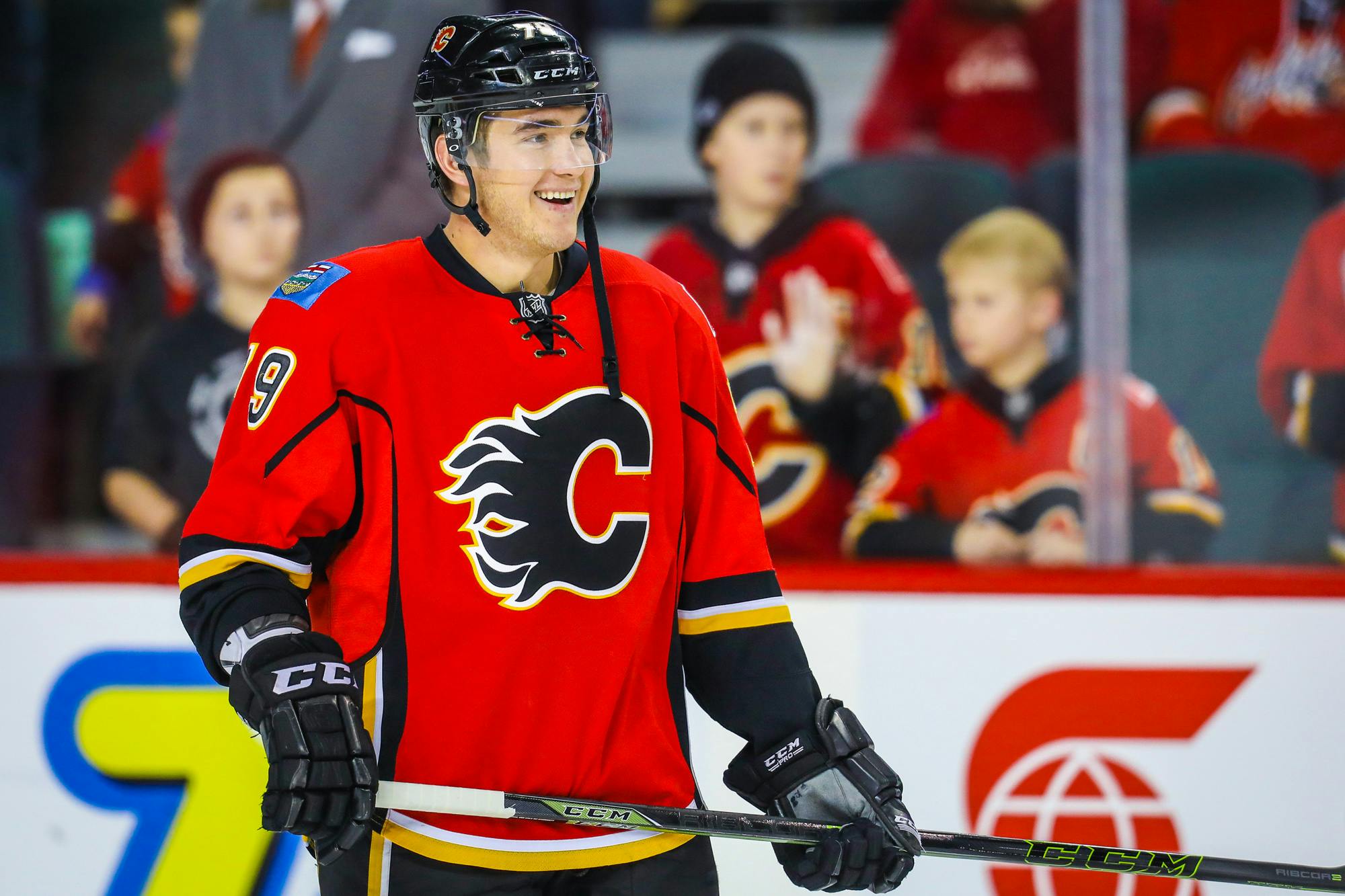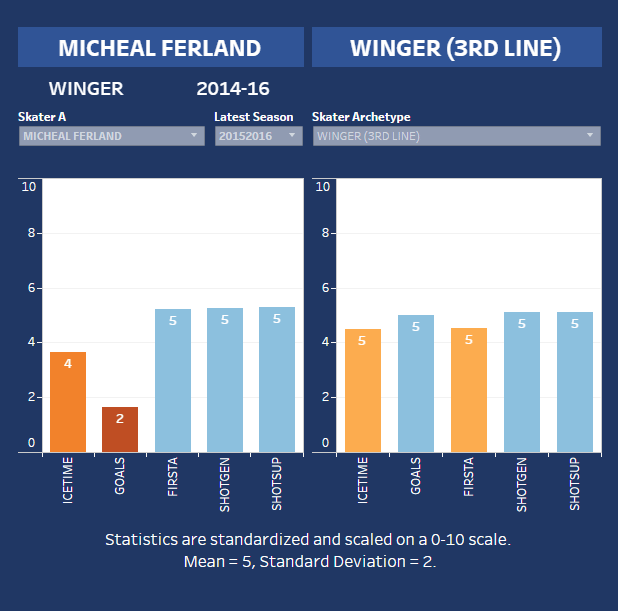FlamesNation Player Evaluations: Micheal Ferland

By Ari Yanover
6 years agoNo matter how you look at it, Micheal Ferland is a success story. He’s a testament to just what can happen when raw talent, combined with the right amount of luck, meets an extremely effective support network.
The Flames chose him in the fifth round back in 2010. He’s come a long way since then, proving himself to be an effective NHLer. Now, the only question that remains is just how high, exactly, is his ceiling?
2016-17 season summary
Ferland’s season has a distinct split: when he was on the fourth line, and when he was on the top line. As a fourth liner he had eight goals and 15 points in 55 games. Extrapolate that to a full season, and he’d have 12 goals and 22 points.
When Ferland was moved up to play alongside Johnny Gaudreau and Sean Monahan, however, things took off. He scored seven goals and 10 points in 21 games. If he maintained that pace over an 82-game season, that would result in 27 goals and 39 points. And while that would be awesome – and it can’t be understated that Ferland was, in fact, awesome to close out the season – those numbers are a bit out of proportion, and put him in “NHL Cy Young” territory (wherein a player’s goals vastly outnumber his assists).
To put it another way: on the fourth line, Ferland had a shooting percentage of 11.9%. On the first line, it shot up to 17.9%. Ferland has a career shooting percentage of 8.0%. This season was way beyond expectations for him, even when he was on the fourth line; however, his NHL career is only 173 games deep, and this was just his second full season, so it’s possible he is a better shooter than his first couple of years gave him credit for – but he’s probably not going to be an 18% guy.
Another way of looking at the split? On the fourth line, Ferland had 1.22 shots per game. On the first, he had 1.86. Given more opportunity and better linemates, Ferland is probably going to be more active with the puck.
And really – that’s what Ferland’s entire season boils down to. Twenty-five points through an entire season isn’t a lot, but it was good enough to tie for 11th on the team, and does hint at offensive potential. Not potential to just be an NHLer – we already know he is one – but potential to be a scorer.
Potential that is not getting the opportunity to be realized. Ferland averaged 11:33 per game throughout the entire year; only Lance Bouma and Garnet Hathaway had less ice time. He played 35:27 on the powerplay throughout the entire year, 14th in ice time. (He scored two goals and four points on the man advantage; probably not a pace he can keep up, but one certainly deserving of more looks than some players got, namely Troy Brouwer, Alex Chiasson, and even Sam Bennett, though Bennett’s use is much more justifiable.)
Right now, 2016-17 looks like it’s Ferland’s breakout season – but he probably has more to offer than this. He just needs the chance to prove it. Via Own The Puck, his ice time has never been up to par:

Compared to last season
Ferland is generally not a liability. He doesn’t play in the most difficult of circumstances, but he’s hardly sheltered, either.

His overall 5v5 CF% of the season clocked in at 49.53%, up a bit from the 48.68% he held in 2015-16. Not everyone on a team is going to be above 50%, but Ferland toeing that line is a good sign. His corsi for this past season seems to have dropped about when the Flames’ as a whole went up in January, which is a bit of a bizarre inverse, but even then he still worked himself back up into positive territory as the year ended.
At absolute worst, he’s still likely to be more helpful than not every time he steps out on the ice.
Most common teammates

For the most part, Ferland appears to have a solid, if unspectacular, effect on his teammates. His presence helped Matt Stajan, Gaudreau, and T.J. Brodie to an extent, while he didn’t have too much of an effect on Monahan, and playing with Dougie Hamilton and Mark Giordano helped him more than he helped them.
Engelland and Bouma are the only real head scratchers here, as they appear to have been better away from Ferland; this likely won’t be revisited in the near future, though.
What’s next?
Ferland’s future is not entirely in his own hands.
If things stay pretty much as they are – namely, if the Flames don’t add any notable new forwards – then the top line right wing spot will probably be his to lose. He finished the end of the regular season on a high note, and Gaudreau and Monahan looked to be at the top of their games when playing alongside Ferland. He’s big and he has talent, so it’s possible he’s the missing piece they need.
But is he the ideal one? Probably not. That’s not a slight on Ferland, but it’s not exactly a secret the Flames could stand to improve their overall forward corps. And if they’re able to get a new name – say a Nino Niederreiter or Kevin Hayes – then there’s plenty of justification to bump Ferland down. He’s had 21 games as a first liner with some potential showing; those other players have already proven more in their NHL careers to date.
That’s not to say Ferland has little value. He’ll almost certainly be protected. If he does end up bumped down the lineup, then he’s just going to make one of those other lines stronger. Sam Bennett had to play alongside Brouwer for much of the season; how much better would he have fared if Ferland was his right winger instead? If the Flames decide to load up the top line by moving Matthew Tkachuk up there, how valuable could Ferland be alongside the other two Mikes on the team? There are a number of options for Ferland, and none of them are particularly bad.
One thing’s for certain, though: he needs ice time, and coaches are out of excuses to not give it to him.
| #1 – Brian Elliott | #5 – Mark Giordano |
| #6 – Dennis Wideman | #7 – T.J. Brodie |
| #10 – Kris Versteeg | #11 – Mikael Backlund |
| #13 – Johnny Gaudreau | #17 – Lance Bouma |
| #18 – Matt Stajan | #19 – Matthew Tkachuk |
| #23 – Sean Monahan | #25 – Freddie Hamilton |
| #26 – Michael Stone | #27 – Dougie Hamilton |
| #29 – Deryk Engelland | #31 – Chad Johnson |
| #36 – Troy Brouwer | #39 – Alex Chiasson |
| #44 – Matt Bartkowski | #61 – Brett Kulak |
| #64 – Garnet Hathaway | #67 – Michael Frolik |
Recent articles from Ari Yanover




